Internacionalista Greta (they/elle/ella) wrote this letter in September, 2024 and revised it in March, 2025.
Today I’d like to write about intergenerational organizing, rural community building, connection to the land, and what it takes to sustain a movement for nearly two decades. These learnings have percolated during accompaniment trips to the departments of Jalapa and Santa Rosa, to visit Xinka people who have been resisting the El Escobal silver mine for seventeen years and counting.
The Recipe
A bit of context. Guatemala is a plurinational state of Indigenous peoples: 22 Maya peoples, each with their own language and culture; the Garífuna people, whose ancestors were free Africans and Indigenous Caribbeans; and the Xinka people, whom historians believe might have originally migrated to southeast Guatemala from pre-Columbian Mexico or from the Andes. Spanish colonizers conscripted Xinkas into involuntary labor and forcibly removed many of them from their territory to work in Honduran, Panamanian, and Peruvian mines (another instance of mines threatening Xinka lifeways), and they have been subject to cultural and linguistic dispossession ever since. The Xinka people are in an active process of recuperating their language and heritage. If you speak Spanish and want to learn more, I would recommend these two podcast episodes by Colectivo Anpük, a community communications project for and by the Xinka people.
Xinka identity is strongly linked to the land—most families derive their livelihood by farming coffee for trade and tending milpa(1), beans, and a variety of animals for subsistence—and the water, sacred to their spirituality. As soon as the US-Canadian mining company Tahoe Resources obtained a license to search for gold, silver, nickel, and other minerals in the town of San Rafael Las Flores in 2007, the surrounding communities knew that it would threaten these sources of life. Tahoe Resources (which closed to avoid lawsuits and sold the mine to Canadian company Pan American Silver in 2019) did not conduct a community consultation, a referendum process guaranteed by international law prior to the operation of an extractive project on Indigenous land, citing a narrative of Xinka erasure that there were no Indigenous peoples there. How wrong they were.
Since 2010, Xinka people in the departments of Santa Rosa, Jalapa, and Jutiapa have launched a campaign to affirm their Indigenous identity despite continued denial by the company. I heard from one Xinka ancestral authority that “la única cosa buena”(2) to come out of the mine is that organizing against it has strengthened them as a people. They petitioned the municipal board for a community consultation three times, each of them rejected, so they exercised their political sovereignty in a big way by conducting their own municipal consultations in over a dozen affected towns. All of them rejected the mine by a 93-100% margin. They organized protests, religious services, and direct actions; the government responded with arrests, and in 2013 they declared a state of siege. Xinka water protectors recall this as a time of heightened military presence, criminalization, and violence, which came to a head in 2014 with the assassination of 16-year-old Topacio Reynoso Pacheco. Ten years later, her legacy and the lack of justice for her murder are still deeply felt. ¡Topacio presente!
Still, the Xinka people continued strong in their fight and began to get some significant wins. In 2017 the Supreme Court ruled that the El Escobal mine suspend operations due to its violation of the Xinka right to a community consultation—woohoo!! In response, the people set up 24-hour resistencias(3) in the towns of Casillas and Mataquescuintla, which stop trucks for a moment as they drive into the mine in order to ensure that it complies with the suspension. In 2024, both resistencias celebrated their 7th anniversary of community members taking 24-hour turnos(4) and working together to provide food, lodging, and transportation to make this possible. I’d like to uplift this domestic labor which the women of the movement usually perform, often with little public recognition.
Win #2: In 2018, the Constitutional Court ordered the government of Guatemala for the first time in the country’s history to conduct a community consultation… and seven years later, it is finally coming to fruition. The first step in the process was the devolución(5), in which leaders presented the environmental and public health impacts of the mine as studied by both state agencies and the community’s own jóvenes científicos(6). Their monitoreo(7) revealed high levels of arsenic, lead, and other heavy metals in the water, which travel up the food chain from fish to humans; a 100-meter drop in water level between 2013 and 2023, which means that people have had to construct wells where previously they could use natural springs; and a high prevalence of cancer, cardiovascular disease, and diabetes in the community, all of which may be linked to water contamination. After the devolución comes the consultation for whether to permit the mine to operate or not. Stay tuned for the results and the next steps!
The Ingredients
So how has the Xinka resistance to the El Escobal mine sustained itself over so many years, stages, retos(8) and delays? I have formulated a few theories during my visits to the territory that I would like to share with you all. These are just a few of the many ingredients which I believe are essential to this movement, and which we can all incorporate into our own.
1. Integration of resistance and everyday life
The very first thing that struck me as I got off the camioneta(9) in Mataquescuintla and stepped into the resistance camp was how normal it felt. Not a dramatic protest or a grand headquarters, just a modest property on the side of the road where ten family members ages eight and up were chatting and playing cards and making lunch. They shared with us the logistics of their monthly journey from their rather far village to cover their shift. With them and nearly everyone I met, I noted how their life seemed to be composed primarily of three interlocking elements: work, family, and fighting this maldita(10) mine. I’ve seen this kind of compromiso(11) among my friends, most of us 20-somethings who can afford to build our life around organizing and field questions like “but why haven’t you gotten a real job yet?” from each others’ parents. But these people have real jobs, hard and time-consuming ones; they’ve got kids and elders to take care of; and chances are, their friends’ parents are the ones coming in to take the next resistencia shift. They have built a movement that can coexist with and sustain a full, fulfilling life, rather than devouring it. This is no small feat in a movement that has been highly criminalized and attacked by the state, the mine, and organizers’ own neighbors. The key is how Xinka land defenders support one another
2. Intergenerational community
If we’re talking ingredients, this is the binding agent that holds our metaphorical cake together. One of the most common lamentations back in my Minneapolis leftist communities is “where are all the movement elders?”. So imagine my delight when, one night at dinner, our host’s father, an ancestral authority for the Xinka people, came over from the house next door and sat down. He shared with us stories from his years of fighting the mine, then genuinely asked us our opinion on a question that had been plaguing him. And when my fellow internacionalista offered a suggestion he liked, he took it.
Intergenerational organizing and exchange of ideas makes the longevity of movements possible. Meetings where parents can bring their kids and hear what they thought on the ride home; organizational bodies that balance the experience of elders with the insight of youth; projects like the community scientists which foster mentorship between generations and build agency for the younger ones. Even the mera(12) structure of Xinka communities, with their ancestral authorities and more-than-nuclear families, gives them internal strength.
3. Connection to the land
The best part of visiting the Xinka territory is the coffee. Or, it would be, if my body didn’t react to caffeine by ceaselessly vibrating and giving me the disposition of a four-year-old and keeping me awake all night. Thankfully, my hosts have been gracious enough to continue speaking to me when I sadly decline their offers of coffee with dinner. One of them even presented me a tea made with the cáscaras(13) of coffee beans, which has since become a staple of my kitchen.

Coffee berries ripen on the plant. Photo by NISGUA Internacionalista. November 2024
Even if I can’t fully appreciate coffee as a beverage, I am learning to love it as a plant and as a way of life. The morning after my embarrassment of drink preference, my host still deigned to give me a tour of his farm, a lush forest filled with not only coffee plants but bananas, lemons, and a lizard whose photo is below. It was clear that to him, caring for coffee meant caring for the land. I was struck by his deep attunement to the impacts of climate change on coffee production: hotter and drier weather leads to smaller yields, so he is replacing his crops with a hybrid variety that combines the heat-resistance of Ethiopian crops with the flavor characteristic to Guatemala. He also shared how he chooses to produce natural coffee, rather than the more common washed method, in order to conserve water and highlight the plant’s original flavor.
As a Vermonter raised on picking my own produce from local farms, tracking how weather patterns affect crops, and resolving to protect my beloved rural environment after learning about climate change, I felt right at home. I could see plainly that my host derived his motivation to shut down the mine from his connection to the land. When something endangers the beings which sustain your life, you have no option but to fight it. Seeing such interdependence and reciprocity reminded me once again of the importance for social movements to root themselves in place.
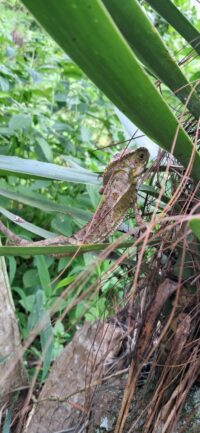
A lizard hangs out in the coffee farm. Photo by NISGUA Internacionalista. August 2024
4. Deep-seated faith
The Catholicism woven tightly into Xinka resistance has been the hardest element for me to grapple with. I come from a mixed Jewish-Protestant family, don’t believe in the God that either of these religions preach, but am committed to learning from both of their traditions while defining my own spirituality. Most Xinkas that I met, on the other hand, ground their struggle solidly in the Catholic church and liberation theology (whether or not they call it by this name). Despite my skepticism of Catholicism, the people I visit have helped me start to see the nuance and value of their faith. One of my hosts told me how fighting the mine is her way of protecting “el bien común”(14) that Catholicism teaches. Another would refer back to God anytime we speculated on the future of the movement. “Dios quiera que la mina cierre,”(15) she would say, or “seguiremos andando con Dios”(16). Instead of viewing this as neglecting her agency, I began to see that she believes she can carry out the will of God, and this faith compels her to continue.
My own faith looks different. Instead of God, it centers the intrinsic connection of all living beings and the potential that our interdependence holds to create other worlds. But it, too, is what keeps me going when our work feels too daunting or our enemies too powerful. It is the reason I seek out anti-Zionist Jewish spaces and spiritual dance experiences and holiday celebrations with my (chosen) family. I am coming to believe that sustaining our self-articulated faiths, wherever they are on the spectrum from religious to secular, is essential to sustaining our movements.
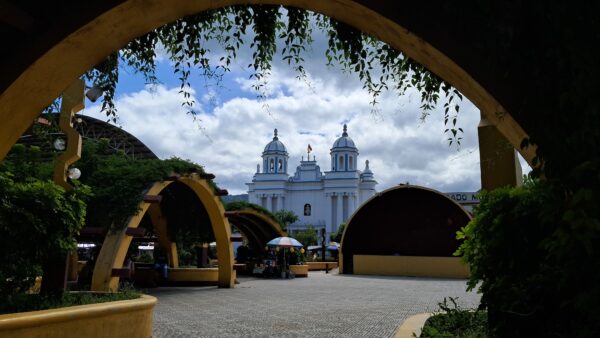
A Catholic church in the center of a town in Santa Rosa. Photo by NISGUA Internacionalista. October 2024
5. Institutional infrastructure
I have heard movements broken down into “fighting the bad” and “building the good,” and I have observed so many ways that this movement is doing both. That first day at the resistance, one of our hosts shared that the camps themselves have reduced crime and sexual violence in the neighborhoods where they are, paving the way for local businesses to open and women to inhabit public space more freely. I nearly laughed with joy at such a clear manifestation of the saying “we keep us safe.” The resistance camps create infrastructure which betters the community. So does the water quality monitoring project, training youth in environmental science; a cooperative called Café Xinka which coffee-growers in the movement launched to sell their product collectively at a fair price; and the effort to affirm Xinka identity and strengthen ancestral practices that has underpinned the entire fight. Countless people I have met have told me that even after they ojalá(17) succeed at shutting down the mine, they will continue en la lucha(18). They will continue fighting against the illegal tala de árboles(19) in their communities, revitalizing their language, strengthening women’s rights, and protecting public health. I am so excited to see what movements emerge from the strong base which the Xinka people have created.
And when they do, NISGUA will continue to stand with them. Because that is another element of institutional infrastructure which helps sustain movements: international solidarity. I am learning that this means more than organizational ties between NISGUA and the Xinka resistance. It means the close personal relationships formed between internacionalistas like myself and the contrapartes(20) we visit. After my very first visit to the resistencia, one member of the outgoing turno(21) offered to give us a ride to our next stop. After we piled our luggage into his pickup truck, grateful, he began telling my fellow accompanier about a town higher up in the mountains and offered to show us the sights. They turned to me in the back seat. “Si no está demasiado fuera de su camino,”(22) I concurred.
It turns out it was out of the way, quite. But he didn’t mind at all. He seemed fueled by his love for his homeland and his eagerness to share it with us. And, I expect, a desire to spend a bit more time acompañado(23). So this is part of what internationalism looks like, I thought. Driving up the mountain, platicando(24). Stopping to take in the view.
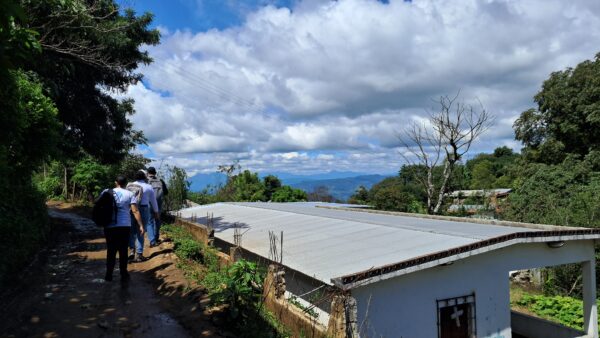
NISGUA staff and partners walk together to an accompaniment visit in Santa Rosa. Photo by NISGUA Internacionalista. October 2024
And afterwards? Continuing to talk about the struggle. To bring it to the public and international eye, to motivate the organizers to continue, to decrease the level of risk that they face, to apply lessons learned to other movements for liberation. If the Xinka people can continue their fight over so much time, why can’t we do the same? Especially within the so-called United States I’ve seen campaigns of all kinds, including defense of territory, lose their strength over the years. If we learn from the people who know how to maintain it, that’s not how it has to be.
Glossary
(1) corn (specifically the plant; the early harvest of cobs are called elote, and the mature kernels are maíz)
(2) the one good thing
(3) resistance camps
(4) shifts
(5) return of information
(6) youth scientists
(7) monitoring
(8) challenges
(9) a big, honking, decked-out and repurposed US school bus
(10) cursed
(11) commitment
(12) very
(13) husks
(14) the common good
(15) God willing, the mine will close
(16) we will continue to walk with God
(17) another way to say God willing
(18) in the struggle
(19) logging
(20) partners
(21) resistance shift
(22) if it’s not too far out of your way
(23) accompanied
(24) chatting

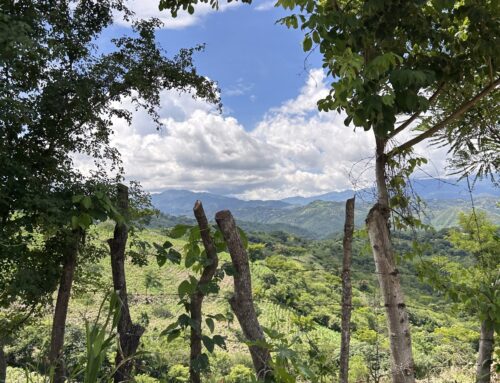
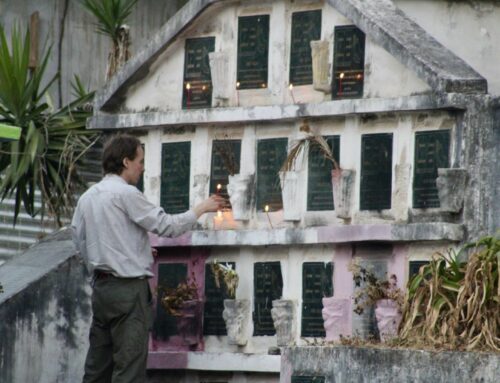

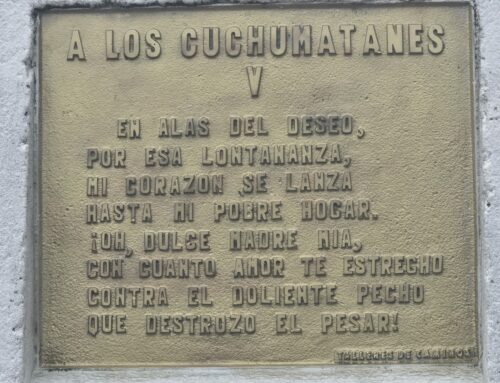
[…] from their time in Guatemala and the lessons this movement offers to organizers everywhere. Read more about what makes this resistance so […]